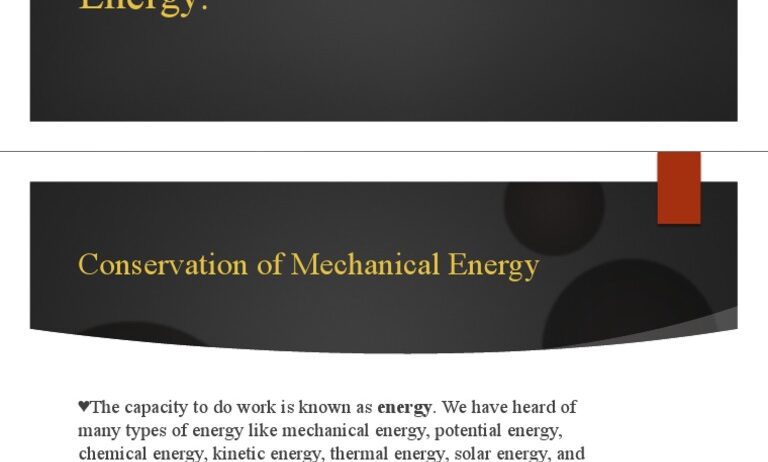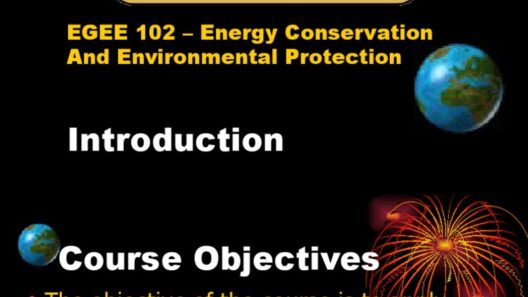The concept of conservation of mechanical energy is a foundational principle in physics that describes the relationship between kinetic energy and potential energy within a closed system. At its core, the principle posits that in the absence of non-conservative forces—such as friction or air resistance—the total mechanical energy of a system remains constant. But what exactly does this mean for our everyday lives, and how does it challenge our understanding of energy management?
To unpack this notion, let’s begin with the definitions of kinetic energy and potential energy. Kinetic energy is the energy of an object in motion and is quantified by the formula ( KE = frac{1}{2}mv^2 ), where ( m ) is mass and ( v ) is velocity. Conversely, potential energy is stored energy based on an object’s position or configuration, often represented in gravitational systems as ( PE = mgh ), where ( g ) is the acceleration due to gravity and ( h ) is height above a reference point.
How do these energies interrelate? Consider a simple pendulum. When pulled back to a certain height, gravitational potential energy is at its peak. As the pendulum swings down, that height decreases, and the potential energy is converted into kinetic energy, reaching its maximum as the pendulum swings through its lowest point. According to the conservation of mechanical energy, the sum of kinetic and potential energy at any point in this motion remains constant, as long as no external forces (like friction) intervene. So, the question arises: can we apply this principle to our approaches to energy consumption?
In practical terms, conservation of mechanical energy suggests a multitude of applications, from amusement park rides to renewable energy technologies. For instance, roller coasters exploit the conservation of energy concept by transforming gravitational potential energy into kinetic energy, allowing for thrilling descents followed by ascents with a minimal energy input. On the other hand, renewable energy sources, such as hydroelectric dams, harness gravitational potential energy stored in elevated water to produce kinetic energy as it rushes down, subsequently converting it into electrical energy.
This principle, clearly derived from classical mechanics, also raises environmental awareness. The idea of conservation echoes not just in mechanical applications but extends into how we harness energy resources and manage consumption. The challenge lies in recognizing inefficiencies that disrupt the seamless dance between kinetic and potential energy in our daily energy use. Consider the energy spent in transportation: how much is lost due to inefficiencies in vehicles that burn fossil fuels? Could more holistic designs that mimic the principles found in nature help us advance toward sustainable practices?
In situations where external forces cause energy dissipation, it raises critical discussions about resource optimization. For instance, in mechanical systems like cars, energy is continually lost through heat and sound. Engineers can improve performance by designing more efficient engines and transmission systems, but the consistent loss of energy raises an ethical dilemma—how best to balance convenience with sustainability?
This philosophical quandary leads us to consider the broader implications of energy conservation. The conservation of mechanical energy nudges us toward a more energy-conscious worldview. If we can genuinely grasp our energy consumption’s mechanistic aspects, we might also reconsider how we expend energy in residential, commercial, and industrial spheres.
In everyday life, consider the implications of energy conservation through simple choices—switching off unused electrical devices, employing energy-efficient appliances, and utilizing renewable sources like solar and wind power. These changes contribute to a more sustainable energy future, aligning personal behavior with a broader agenda for environmental stewardship.
To make the concept of energy conservation more tangible, think about energy-efficient retrofitting in buildings. By enhancing thermal insulation, upgrading heating systems, or leveraging smart technology for energy management, we can drastically minimize energy wastage. These methodologies could enhance the overall mechanical energy dynamics within built environments—an empowering notion that suggests individual actions can coalesce to form larger environmental impacts.
The challenge is formidable and multifaceted: How do we effectively transfer the theoretical framework of mechanical energy conservation into practical, widespread applications? As the world grapples with climate change and dwindling fossil fuel reserves, the integration of sustainability into every facet of energy use is not merely prudent but imperative.
When we understand conservation on both mechanical and environmental levels, we grasp the systematized interplay between resources and waste. By valuing every joule of energy and considering where it comes from and where it goes, we may cultivate a culture that respectfully honors our planet’s resources.
Ultimately, the conservation of mechanical energy exemplifies a broader philosophical stance towards environmental responsibility; it reminds us of the interconnectedness of all systems. Maintaining equilibrium in mechanical energy translates into maintaining equilibrium in our ecological practices. Hence, the pursuit of energy conservation is not merely a technical endeavor but a lifestyle approach—one that challenges us to engage more thoughtfully with the resources that fuel our lives. Can we rise to meet this challenge, ensuring future generations inherit a world where energy is not only preserved but treasured?








